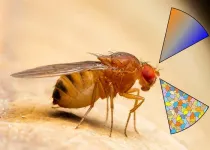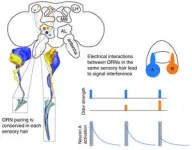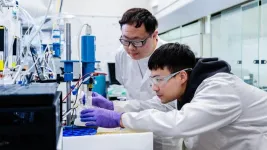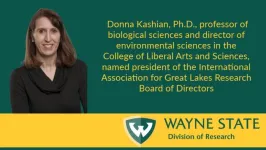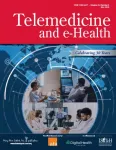(Press-News.org) Whether it’s the wafting aroma of our favorite meal or the dangerous fumes seeping from a toxic chemical, the human sense of smell has evolved into a sophisticated system that processes scents through several intricate stages. The brains of mammals have billions of neurons at their disposal to recognize odors they are exposed to, from pleasant to pungent.
Insects such as fruit flies, on the other hand, have a mere 100,000 neurons to work with. Yet their survival is dependent upon their ability to decipher the meaning of complex odor mixtures around them to locate food, seek potential mates and avoid predators. Scientists have pondered how insects are able to smell, or extract information from odors, with a much smaller olfactory sensory system compared with mammals.
Scientists at the University of California San Diego believe they have an answer to this puzzling question. Palka Puri, a physics Ph.D. student, together with Postdoctoral Scholar Shiuan-Tze Wu, Associate Professor Chih-Ying Su and Assistant Professor Johnatan Aljadeff (all in the Department of Neurobiology) have uncovered how fruit flies use a simple, efficient system to recognize odors.
“Our work sheds light on the sensory processing algorithms insects use to respond to complex olfactory stimuli,” said Puri, the first author of the paper, published in the Proceedings of the National Academy of Sciences. “We showed that the specialized organization of insect sensory neurons holds the key to the puzzle — implementing an essential processing step that facilitates computations in the central brain.”
Previous investigations of the odor processing system in flies focused on the central brain as the main hub for processing odor signals. But the new study shows that the effectiveness of the insect’s sensory capabilities relies on a “pre-processing” stage in the periphery of their sensory system, which prepares the odor signals for computations that occur later in the central brain region.
Flies smell through their antennae, which are replete with sensory hairs that detect elements of the environment around them. Each sensory hair usually features two olfactory receptor neurons, or ORNs, that are activated by different odor molecules in the environment. Intriguingly, ORNs in the same sensory hair are strongly coupled by electrical interactions.
“This scenario is akin to two current-carrying wires placed close together,” explained Puri. “The signals carried by the wires interfere with each other through electromagnetic interactions.”
In the case of the fly olfactory system, however, this interference is beneficial. The researchers showed that as flies encounter an odor signal, the specific pattern of interference between the receptors helps flies quickly compute the “gist” of the odor’s meaning: “Is it good or bad for me?” The result of this preliminary evaluation in the periphery is then relayed to a specific region in the fly’s central brain, where the information about odors present in the outside world is translated to a behavioral response.
The researchers constructed a mathematical model of how odor signals are processed by electrical coupling between ORNs. They then analyzed the wiring diagram (“connectome”) of the fly brain, a large-scale dataset generated by scientists and engineers at Howard Hughes Medical Institute’s research campus. This allowed Puri, Aljadeff and their colleagues to trace how odor signals from the sensory periphery are integrated in the central brain.
“Remarkably, our work shows that the optimal odor blend — the precise ratio to which each sensory hair is most sensitive — is defined by the genetically predetermined size difference between the coupled olfactory neurons,” said Aljadeff, a faculty member in the School of Biological Sciences. “Our work highlights the far-reaching algorithmic role of the sensory periphery for the processing of both innately meaningful and learned odors in the central brain.”
Aljadeff describes the system with a visual analogy. Like a specialized camera that can detect specific types of images, the fly has developed a genetically driven method to distinguish between images, or in this case, mixtures of odors.
“We discovered that the fly brain has the wiring to read the images from this very special camera to then initiate behavior,” he said.
To arrive at these results, the research was integrated with previous findings from Su’s lab that described the conserved organization of ORNs in the fly olfactory system into sensory hairs. The fact that signals carried by the same odor molecules always interfere with each other, in every fly, suggested to the researchers that this organization has meaning.
“This analysis shows how neurons in higher brain centers can take advantage of balanced computation in the periphery,” said Su. “What really brings this work to another level is how much this peripheral pre-processing can influence higher brain function and circuit operations.”
This work may inspire research into the role of processing in peripheral organs in other senses, such as sight or hearing, and help form a foundation for designing compact detection devices with the ability to interpret complex data.
“These findings yield insight into the fundamental principles of complex sensory computations in biology, and open doors for future research on using these principles to design powerful engineered systems,” said Puri.
END
Detecting odors on the edge: Researchers decipher how insects smell more with less
Receptors on fly antennae work in pairs to process vital odor information
2024-05-21
ELSE PRESS RELEASES FROM THIS DATE:
Recycling carbon dioxide into household chemicals
2024-05-21
A low-cost, tin-based catalyst can selectively convert carbon dioxide to three widely produced chemicals — ethanol, acetic acid and formic acid.
Lurking within the emissions from many industrial operations is an untapped resource — carbon dioxide (CO2). A contributor of greenhouse gas and global warming, it could instead be captured and converted to value-added chemicals.
In a collaborative project involving the U.S. Department of Energy’s (DOE) Argonne National Laboratory, Northern Illinois University and Valparaiso University, ...
Wayne State faculty member named president of the International Association for Great Lakes Research board
2024-05-21
DETROIT —
The International Association for Great Lakes Research today announced its new board of directors and has named Donna Kashian, Ph.D., professor of biological sciences and director of environmental sciences in the College of Liberal Arts and Sciences at Wayne State University, as president. Kashian previously served as vice president of the board.
Founded in 1967, the International Association for Great Lakes Research is a scientific organization made up of researchers studying the Laurentian Great Lakes, other large lakes of the world and their watersheds, as well as those ...
Consultative support to pediatric primary care providers in providing gender-affirming care
2024-05-21
New Rochelle, NY, May 21, 2024—A new study in the peer-reviewed journal Telemedicine and e-Health found that access to consultative support can increase pediatric primary care provider comfort providing gender-affirming care. Click here to read the article now.
The literature suggests that access to gender-affirming medical care is associated with improved medical outcomes among adolescents who identify as gender diverse or endorse a gender identity that differs from their sex assigned at birth. An increasing number of gender diverse youth seek guidance and support from their pediatric primary care providers (PPCPs), who often lack adequate training in this ...
Alaska’s rusting waters: Pristine rivers and streams turning orange
2024-05-21
Dozens of Alaska’s most remote streams and rivers are turning from a crystal clear blue into a cloudy orange, and the staining could be the result of minerals exposed by thawing permafrost, new research in the Nature journal Communications: Earth and Environment finds.
For the first time, a team of researchers from the National Park Service, U.S. Geological Survey, the University of California, Davis, and other institutions have documented and sampled some of the impaired waters, pinpointing ...
Jefferson Lab director named to 2024 Hampton Roads Power List
2024-05-21
NEWPORT NEWS, VA – Stuart Henderson, director of the U.S. Department of Energy's Thomas Jefferson National Accelerator Facility, has been named to the Hampton Roads Power List by Inside Business. The list recognizes the major players in Hampton Roads’ economy. According to Inside Business, the 2024 list considered milestones and current events, and it features “the talk of Hampton Roads and the change that’s coming.”
“I am honored to be included in this list of people who are moving Hampton ...
New crystal production method could enhance quantum computers and electronics
2024-05-21
Irvine, Calif., May 21, 2024 — In a study published in Nature Materials, scientists from the University of California, Irvine describe a new method to make very thin crystals of the element bismuth – a process that may aid the manufacturing of cheap flexible electronics an everyday reality.
“Bismuth has fascinated scientists for over a hundred years due to its low melting point and unique electronic properties,” said Javier Sanchez-Yamagishi, assistant professor of physics & astronomy at UC Irvine and a co-author of the study. “We developed a new method to make very thin crystals ...
Inherited genes play a larger role in melanoma risk than previously believed
2024-05-21
CLEVELAND - When it comes to skin cancer, most people think of warnings about sunburn and tanning beds. Thoughts of “cancer genes” or inherited risks are reserved for diseases like breast cancer or colon cancer. A new study challenges this status quo by showing that genetics play a larger role in melanoma risk than recognized.
Physicians rarely order genetic screens to assess risk factors for patients with a family history of melanoma because, according to the previous, limited studies, only 2-2.5% of all cases are genetic. For the same reason, insurance companies rarely cover these tests outside of the most extreme ...
Two promising UCF researchers earn 2024 NSF CAREER Awards
2024-05-21
Two Promising UCF Researchers Earn 2024 NSF CAREER Awards
Early-career professors Fan Yao and Li Fang are receiving significant research funding to continue catalyzing their work as part of an annual NSF grant program.
By Eddy Duryea ’13
ORLANDO, May 21, 2024 – UCF assistant professors Li Fang and Fan Yao have been named 2024 U.S. National Science Foundation (NSF) Faculty Early Career Development program (CAREER) award winners. The recipients were awarded funding through five years for their submitted projects.
Fang, who is an assistant professor in UCF’s Department of Physics within the College of Sciences, is using the ...
Study comparing U-M Weight Navigation Program with usual care for high-risk patients shows higher use of evidence-based treatments and more weight lost
2024-05-21
Giving high-risk patients access to an obesity specialist through their regular primary care clinic increased their chances of receiving at least one evidence-based weight-management treatment, and led to more weight lost in just a year, a new University of Michigan study finds.
Primary care clinicians commonly struggle to help patients develop an individualized weight-management treatment plan during short clinic visits. Previous U-M research showed that most primary care patients with ...
Stuart Orkin awarded the Shaw Prize in Life Science & Medicine 2024 for groundbreaking hemoglobin research
2024-05-21
[BOSTON, MAY 21, 2024] – Stuart Orkin, MD, a researcher at the Dana-Farber/Boston Children's Cancer and Blood Disorders Center and David G. Nathan Distinguished Professor of Pediatrics at Harvard Medical School, has been honored with The Shaw Prize in Life Science & Medicine for his pioneering work discovering the genetic and molecular mechanisms underlying the switch from fetal to adult hemoglobin. Dr. Orkin shares the prize with Swee Lay Thein, PhD, Senior Investigator and Chief of the Sickle Cell Branch of National Heart, ...
LAST 30 PRESS RELEASES:
Making lighter work of calculating fluid and heat flow
Normalizing blood sugar can halve heart attack risk
Lowering blood sugar cuts heart attack risk in people with prediabetes
Study links genetic variants to risk of blinding eye disease in premature infants
Non-opioid ‘pain sponge’ therapy halts cartilage degeneration and relieves chronic pain
AI can pick up cultural values by mimicking how kids learn
China’s ecological redlines offer fast track to 30 x 30 global conservation goal
Invisible indoor threats: emerging household contaminants and their growing risks to human health
Adding antibody treatment to chemo boosts outcomes for children with rare cancer
Germline pathogenic variants among women without a history of breast cancer
Tanning beds triple melanoma risk, potentially causing broad DNA damage
Unique bond identified as key to viral infection speed
Indoor tanning makes youthful skin much older on a genetic level
Mouse model sheds new light on the causes and potential solutions to human GI problems linked to muscular dystrophy
The Journal of Nuclear Medicine ahead-of-print tip sheet: December 12, 2025
Smarter tools for peering into the microscopic world
Applications open for funding to conduct research in the Kinsey Institute archives
Global measure underestimates the severity of food insecurity
Child survivors of critical illness are missing out on timely follow up care
Risk-based vs annual breast cancer screening / the WISDOM randomized clinical trial
University of Toronto launches Electric Vehicle Innovation Ontario to accelerate advanced EV technologies and build Canada’s innovation advantage
Early relapse predicts poor outcomes in aggressive blood cancer
American College of Lifestyle Medicine applauds two CMS models aligned with lifestyle medicine practice and reimbursement
Clinical trial finds cannabis use not a barrier to quitting nicotine vaping
Supplemental nutrition assistance program policies and food insecurity
Switching immune cells to “night mode” could limit damage after a heart attack, study suggests
URI-based Global RIghts Project report spotlights continued troubling trends in worldwide inhumane treatment
Neutrophils are less aggressive at night, explaining why nighttime heart attacks cause less damage than daytime events
Menopausal hormone therapy may not pose breast cancer risk for women with BRCA mutations
Mobile health tool may improve quality of life for adolescent and young adult breast cancer survivors
[Press-News.org] Detecting odors on the edge: Researchers decipher how insects smell more with lessReceptors on fly antennae work in pairs to process vital odor information
